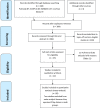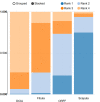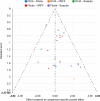Survival of vascularized osseous flaps in mandibular reconstruction: A network meta-analysis
- PMID: 34679077
- PMCID: PMC8535428
- DOI: 10.1371/journal.pone.0257457
Survival of vascularized osseous flaps in mandibular reconstruction: A network meta-analysis
Abstract
Objective: An evidence regarding which bony flap for reconstruction of mandibular defects following tumour resection is associated with the highest survival rate is still lacking. This network meta-analysis (NMA) aimed to guide surgeons selecting which vascularized osseous flap is associated with the highest survival rate for mandibular reconstruction.
Methods: From inception to March 2021, PubMed, Embase, Scopus, and Cochrane library were searched to identify the eligible studies. The outcome variable was the flap survival rate. The Bayesian NMA accompanied by a random effect model and 95% credible intervals (CrI) was calculated.
Results: Twenty-two studies with a total of 1513 patients, comparing four osseous flaps namely fibula free flap (FFF), deep circumferential iliac artery flap (DCIA), scapula flap, and osteocutaneous radial forearm flap (ORFF) were included. The respective survival rates of FFF, DCIA, Scapula, and ORFF were 94.50%, 93.12%, 97%, and 95.95%. The NMA failed to show a statistically significant difference between all comparators (FFF versus DCIA (Odd ratio, 1.8; CrI, 0.58,5.0); FFF versus ORFF (Odd ratio, 0.57; CrI, 0.077; 2.9); FFF versus scapula flap (Odd ratio, 0.25; CrI, 0.026; 1.5); DCIA versus ORFF (Odd ratio, 0.32; CrI, 0.037; 2.1); DCIA versus scapula flap (Odd ratio, 0.14; CrI, 0.015; 1.1) and ORFF versus scapula flap (Odd ratio, 2.3; CrI, 0.16; 34)).
Conclusion: Within the limitations of the current NMA, FFF, DCIA, Scapula, and ORFF showed a comparable survival rate for mandibular reconstruction. Although the scapula flap reported the highest survival rate compared to other osseous flaps for mandibular reconstruction; however, the decision making when choosing an osseous flap should be based on many factors rather than simply flap survival rate.
Conflict of interest statement
The authors reported no conflicts of interest related to this study.
Figures






Similar articles
-
Mini-plate versus reconstruction bar fixation for oncologic mandibular reconstruction with free fibula flaps: A systematic review and meta-analysis.J Plast Reconstr Aesthet Surg. 2022 Aug;75(8):2691-2701. doi: 10.1016/j.bjps.2022.04.097. Epub 2022 May 6. J Plast Reconstr Aesthet Surg. 2022. PMID: 35752590 Free PMC article.
-
Survival of microvascular free flaps in mandibular reconstruction: A systematic review and meta-analysis.Microsurgery. 2015 Oct;35(7):576-87. doi: 10.1002/micr.22471. Epub 2015 Oct 9. Microsurgery. 2015. PMID: 26452240
-
Mandibular reconstruction: meta-analysis of iliac- versus fibula-free flaps.ANZ J Surg. 2016 May;86(5):337-42. doi: 10.1111/ans.13274. Epub 2015 Sep 1. ANZ J Surg. 2016. PMID: 26331293
-
Outcomes of free flap reconstruction for mandibular ORN: Systematic review and meta-analysis.Am J Otolaryngol. 2025 Jan-Feb;46(1):104508. doi: 10.1016/j.amjoto.2024.104508. Epub 2024 Nov 14. Am J Otolaryngol. 2025. PMID: 39580338
-
Systemic pharmacological treatments for chronic plaque psoriasis: a network meta-analysis.Cochrane Database Syst Rev. 2021 Apr 19;4(4):CD011535. doi: 10.1002/14651858.CD011535.pub4. Cochrane Database Syst Rev. 2021. Update in: Cochrane Database Syst Rev. 2022 May 23;5:CD011535. doi: 10.1002/14651858.CD011535.pub5. PMID: 33871055 Free PMC article. Updated.
Cited by
-
Short and Extra Short Dental Implants in Osseous Microvascular Free Flaps: A Retrospective Case Series.J Pers Med. 2024 Apr 3;14(4):384. doi: 10.3390/jpm14040384. J Pers Med. 2024. PMID: 38673010 Free PMC article.
-
Multi-factor early monitoring method based on D-dimer for iliac crest flap loss.BMC Oral Health. 2024 Aug 17;24(1):963. doi: 10.1186/s12903-024-04712-w. BMC Oral Health. 2024. PMID: 39154010 Free PMC article.
-
Anatomical study of the vascularization of the pedicled osteo-myo-cutaneous scapulo-dorsal flap.Surg Radiol Anat. 2025 Jan 2;47(1):51. doi: 10.1007/s00276-024-03559-8. Surg Radiol Anat. 2025. PMID: 39745623
-
Training of Oral and Maxillofacial Surgery Residents in Virtual Surgical Planning: A Feasibility Study Comparing Open-Source Freeware and Commercially Available Software for Mandibular Reconstruction with Fibula Free Flap.Craniomaxillofac Trauma Reconstr. 2025 Feb 3;18(1):10. doi: 10.3390/cmtr18010010. eCollection 2025 Mar. Craniomaxillofac Trauma Reconstr. 2025. PMID: 40271475 Free PMC article.
-
Outcome Assessment after Reconstruction of Tumor-Related Mandibular Defects Using Free Vascularized Fibular Flap-A Clinical Study.Healthcare (Basel). 2023 Jan 9;11(2):193. doi: 10.3390/healthcare11020193. Healthcare (Basel). 2023. PMID: 36673561 Free PMC article.
References
-
- Tarsitano A, Del Corso G, Ciocca L, Scotti R, Marchetti C. Mandibular reconstructions using computer-aided design/computer-aided manufacturing: A systematic review of a defect-based reconstructive algorithm. J Cranio-Maxillofacial Surg. 2015;43: 1785–1791. doi: 10.1016/j.jcms.2015.08.006 - DOI - PubMed
Publication types
MeSH terms
LinkOut - more resources
Full Text Sources

